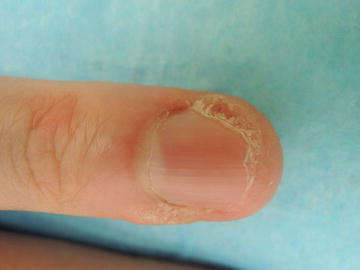, Corinna Eleni Psomadakis2 and Bobby Buka3
(1)
Department of Family Medicine, Mount Sinai School of Medicine Attending Mount Sinai Doctors/Beth Israel Medical Group-Williamsburg, Brooklyn, NY, USA
(2)
School of Medicine Imperial College London, London, UK
(3)
Department of Dermatology, Mount Sinai School of Medicine, New York, NY, USA
Keywords
VerrucaWartsNailsPeriungualHuman papillomavirus
Fig. 9.1
(a–c) Hyperkeratotic , firm, verrucous papules periungal

Fig. 9.2
Lesions that extend subungually can be particularly challenging to treat
Primary Care Visit Report
A 32-year-old male with no past medical history presented with redness, scaling, and induration around his fingernails for 1 year. He had previously been prescribed terbinafine cream, which improved the redness but the periungual rash persisted.
Vitals were normal. On exam, verrucous, well-demarcated, skin-colored to lightly pigmented papules and erythema were present on the periungual areas of all digits. Some induration and scaling was noted.
The differential considered was warts (or verrucae ) alone versus verrucae accompanied by fungal involvement as the patient reported improvement with terbinafine. The patient was referred to dermatology for further evaluation.
Discussion from Dermatology Clinic
Differential Dx
Periungual warts
Acquired periungual fibrokeratoma
Lichen planus
Angiokeratoma
Onychomatricoma
Periungual callus
Squamous cell carcinoma
Favored Dx
Some of the patient’s lesions feature the dark, central puncta typical of common warts. The appearance and history is consistent with verrucous lesions.
Overview
Cutaneous warts are more prevalent in men than women. The median affected age in both genders is during the third decade, but prevalence peaks in school-age years. Palms and feet are the most commonly affected sites although they can occur anywhere on the body [1]. Warts may appear more frequently in immunosuppressed populations, such as organ transplant recipients, or those with HIV infections, and demonstrate more extensive involvement and recalcitrance in those cases.
Cutaneous warts are caused by human papillomavirus . Over 150 different strains have been identified, but HPV 1, 2, 4, 7, 27, 57, and 65 appear to be frequently linked with cutaneous warts [2, 3]. Rarely, types 16 and 18 can cause periungual warts and are considered high risk for transforming into squamous cell carcinoma.
Presentation
Periungual warts are warts that appear adjacent to nails of the hands and feet. Warts typically present as small, rough, cauliflower-like papules. Black puncta, tiny dots representing blood vessels, often appear at the center of the hyperkeratotic, dome-shaped lesions. These may also cause pinpoint bleeding if the growth is shaved down. Warts in children may resolve spontaneously over a period of several months to a year, while they may persist for several years in adults.
Workup
Clinical examination is usually sufficient for diagnosis. Biopsy should be performed in immunocompromised patients, or in recalcitrant, long-standing warts to rule out high risk strains of HPV, Bowen’s disease, and squamous cell carcinoma [4].
Treatment
The approaches to wart treatment include topical, intralesional, and laser therapies. Surgical options include electrodesiccation, a tissue destruction technique using electrical current, and excision but are not first-line due to risk of scarring and the likelihood of recurrence [5]. The elected therapy should take into account patient age and immunity, tolerance for discomfort, lesion size and number, and desired speed to resolution.
Stay updated, free articles. Join our Telegram channel

Full access? Get Clinical Tree








